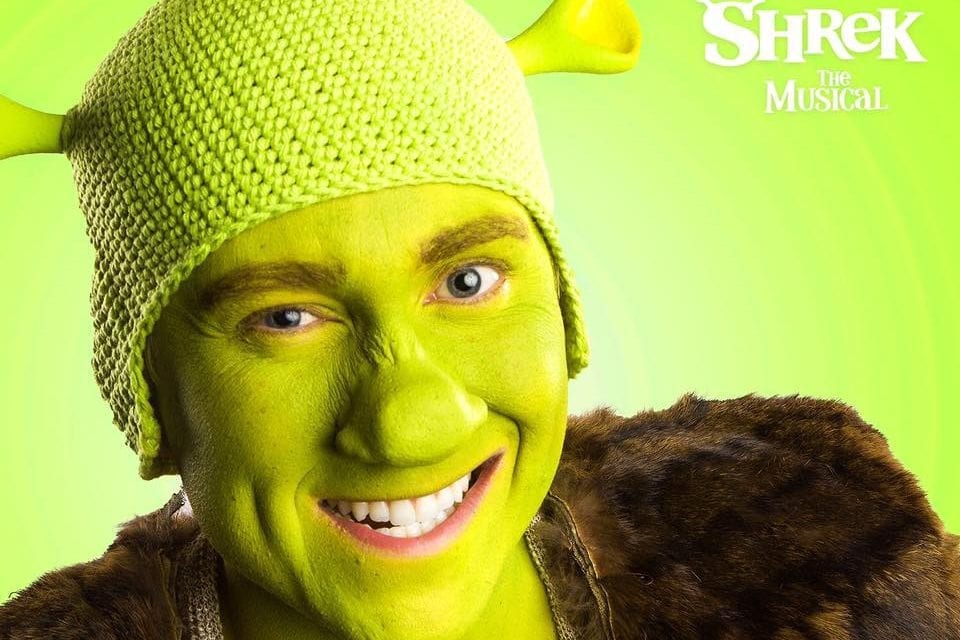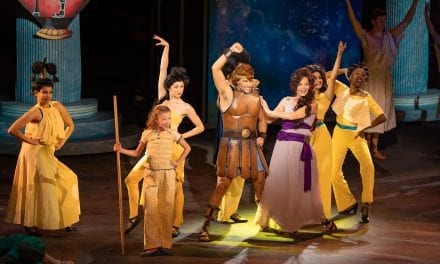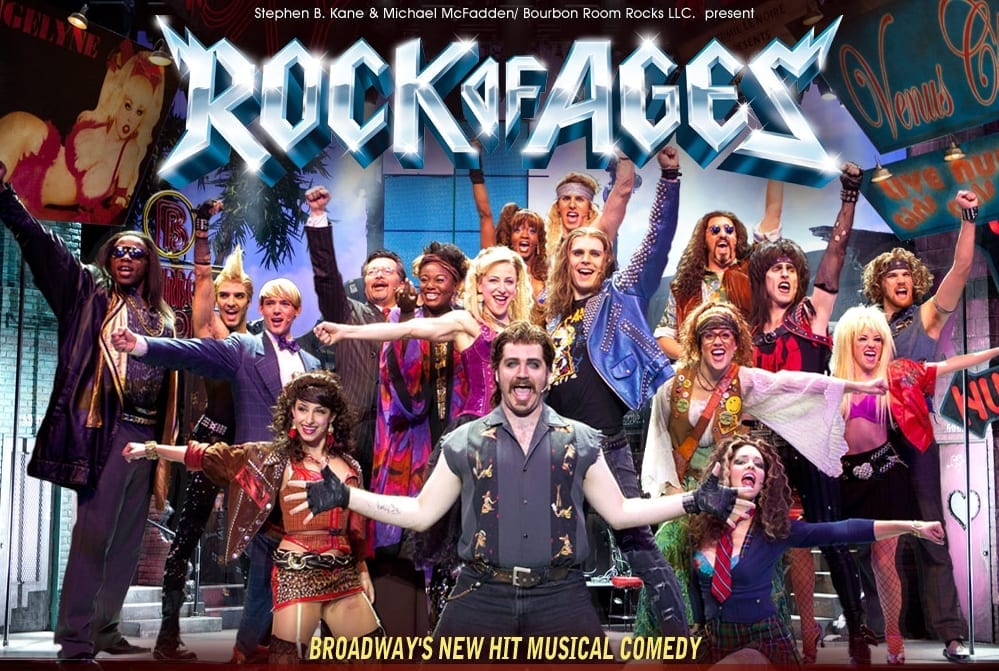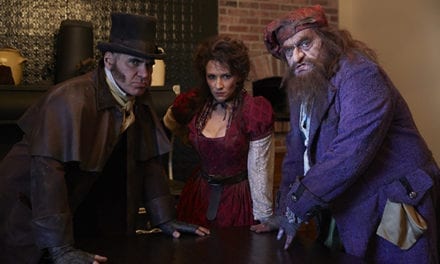GARDEN CITY — What started as the DreamWorks animated film Shrek in 2001 transferred to Broadway in 2008 in a re-imagined state as Shrek the Musical. The script by David Lindsay-Abaire and new songs of Jeanine Tesori combine to bring audiences more than just the familiar story of the main characters Shrek, Donkey, Fiona, and Lord Farquaad. This retelling not only adds backstory to deepen the primary plot, but also relies heavily on the presence and talents of a cast of fairy tale creatures to broaden the story’s scope and add opportunity for flashy production numbers. The end result is a fast-paced comedy full of one of Shrek’s favorite features: layers.

Show closes September 1, 2017.
On the surface, this Pickleville Playhouse production tells a slightly atypical version of the tried and true hero-gets-the-girl story. Dig a little deeper, however, and the fairy tale creatures will say that true love is all about loving yourself for who you are. For me, it was this ensemble cast that deserves the kudos for bringing this typically animated story to life on stage. Nathan Sheppard’s Pinocchio impressively carried his falsetto speaking voice through each of his solo opportunities. As the Wicked Witch, each of Kenzie Davis‘s physical movements was captivating, especially when she was dancing. Voicing both the puppet Gingy and appearing fully as the Fairy Godmother, Julia Davis was the standout vocalist of the evening. Rounding out the fairy tale bunch were Slater Ashenhurst as the Big Bad Wolf, Sara Sanderson as Peter Pan, Emma Larsen as the Elf, and Jayden Blanch playing all Three Little Pigs. Together, this group delivered both precision and energy throughout their harmonies and choreography.
Focusing more specifically on the leads, I have to admit my general dislike of animated features taken to the live stage. In these sorts of productions, I feel the actors are often asked to recreate a character instead of being given the freedom to develop something more genuine and believable. Whether this request comes from the directors (T. J. Davis and Derek Davis in this production), or is dictated by the expectations of the audience is difficult to say. However, the task of bringing the original dynamic voices of Mike Myers and Eddie Murphy to the stage coupled with the limitations of being an actual human instead of computerized creation is a difficult one to tackle. As Shrek and Donkey respectively, Derek Davis and Quinn Osborne stepped confidently to the plate. In many moments, including Shrek’s opportunities to reflect on his childhood, Derek Davis added a convincing layer of vulnerability to Shrek’s closed nature. However, his accent often wavered, especially as he applied it to song lyrics. Osborne’s heavy makeup, part of Whitley O. Davis‘s costume design, made it difficult to distinguish his facial expressions and often pulled his features into nearly grotesque configurations. In a later second act scene, Donkey turned completely sideways to engage in an impassioned argument with Shrek. In this scene with his face seen only in profile, I finally enjoyed Osborne’s delivery and found myself wishing he’d spoken more often to Shrek instead of focusing toward the audience through so much of the show.

Derek Davis as Shrek
The overall production quality of this show was extremely high, with intricately detailed costumes, movable set pieces, and lighting effects used to advance the plot. I particularly appreciated the attention paid to the costume of each fairy tale creature, giving each wigs and other accessories consistent with the character. I also appreciated the care taken not to borrow from the common Disney portrayals of these characters but rather to present a specific interpretation of a more generic concept. Kenneth Bell, Derek Davis, and T. J. Davis collaborated on the set design which included sections of steps that could be reconfigured to meet the needs of each scene. In lieu of a painted backdrop, most scenes were set by images displayed on a three-by-three television screen grid. I found this to be neither distracting nor particularly impressive, with the exception of the scene in which Fiona awakens early and sings in a field of sunflowers. Whitley O. Davis as Fiona looked picturesque standing in front of the expansive field as the sun rose, an effect that would have been difficult to recreate with more traditional lighting and set design. Tanner Funk’s use of color-specific lighting reduced the need for green makeup and gave the combined feelings of heat and danger within the dragon-guarded castle. These simple additions contributed specifically to these scenes. However, at other times, such as when spotlighting each fairy tale character during “Story of my Life,” the lighting felt unnecessarily complex.

Kayli Checketts as Fiona.
Throughout this production, the directors paid great attention to the small details. By incorporating a skunk with functional aerosol spray and commissioning Lord Farquaad’s horse to be nearly too tall for the stage, they set a standard that required little on the part of my imagination. Additionally, under the music direction of T. J. Davis and Luke Shepherd, each soloist of the evening seemed more stellar than the one before. Young Fiona (played by Kayli Checketts) was one of the most impressive of the evening, delivering her portions of “I Know It’s Today” with a strong but appropriately youthful tone. I was also impressed by the tenor notes Nathan Kremin voiced as Lord Farquaad in ensemble configurations. Therefore, I waited in eager anticipation of the larger-than-life dragon I was sure would take the stage. I was equally disappointed to be met with only a stage hand wielding the head of a dragon and that the dragon’s belty anthem “Forever” had been cut entirely. In fact, the entire subplot between Donkey and Dragon was removed from this production, leaving holes in the plot that were filled only weakly by allusions.
Despite providing solid entertainment throughout the evening, this production of Shrek the Musical fell short of fantastic. While fun numbers such as “I Got You Beat” gave Shrek and Fiona a chance to let loose, many of the scenes featuring main characters failed to meet the high standards the ensemble set in “Freak Flag” and “Story of my Life.” Even though the show had its flaws, if you find yourself “far, far away” near Bear Lake this summer, this Pickleville Playhouse production provides a great way to entertain the family.





